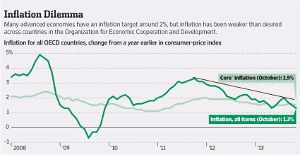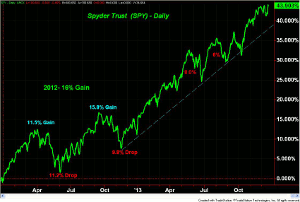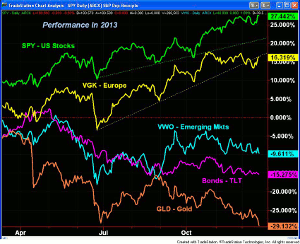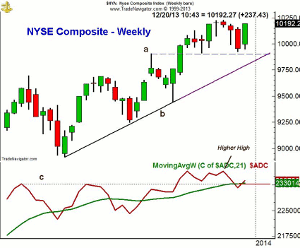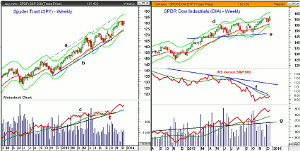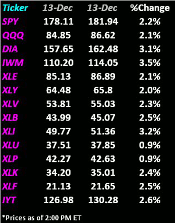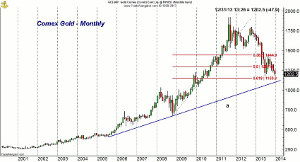With the question of whether or not the Fed will start tapering out of the way, MoneyShow’s Tom Aspray turns his focus towards what’s in store for market participants in the new year.
The FOMC caught many by surprise last Wednesday, myself included, as stock prices exploded to the upside and closed with impressive gains. It appears that the FOMC struck a good medium between slightly reducing their bond buying and declaring their plan to keep rates low for quite some time.
My argument last week was that the threat of deflation would keep the Fed from acting. Obviously, it did not, though Mr. Bernanke did comment that “The committee is determined to avoid inflation that is too low, as well as inflation that is too high.”
As we enter 2014, I think deflation will continue to be a concern for the advanced countries. The chart last week from the WSJ shows that inflation for all OECD countries is in a well-established downtrend, and in most countries, well below their central bank’s targets.
If the S&P 500 were to correct sharply in the last two weeks of the year and drop 5%, the Spyder Trust (SPY) would still be up over 24% for the year. This has given many money mangers fits as at the end of the 3rd quarter, the average hedge fund was only up about 6%. Since many charge a management fee of 2%, facing their clients after this kind of year won’t be pleasant.
No matter what happens in the last two weeks of the year, 2013 will clearly stand out as a buy-and-hold year with index funds as the star performers. The iShares Russell 2000 Index (IWM) is currently up 34.1% YTD, followed closely by the 33% gain in the PowerShares QQQ Trust (QQQ).
Both have done significantly better than the Spyder Trust (SPY), which is up 29.32%, and the 26.52% gain in the SPDR Dow Industrials (DIA). But will buy and hold work again in 2014?
The chart above shows the percentage performance of the Spyder Trust (SPY) since 2012 when it was up 16% for the year. In 2012, there were two significant corrections. In April, it was up 11.5% for the year before it dropped 11.2%. This almost erased all of the year’s gains and likely took many out of the market.
By the middle of September 2012, the SPY was up 15.8% for the year but promptly gave back 9.8% of this gain in the post-election decline. The chart shows that 2013 was a much different year as after being up 32.5% in May (since 2012), the SPY has its worst correction as it dropped 6.4% from high to low.
There was another correction in August as well as from the mid-September to early October as the government shutdown spooked investors. The uptrend in SPY has been much clearer in 2013 than it was in 2012. The break of the uptrend from the late 2012 lows in October 2013 was very brief.
Three or more years of consecutive double-digit gains in the S&P 500 are quite rare. Since 1975, there has been only one example. From 1995 through 1998, the S&P 500 had gains of 34.1%, 20.2%, 31%, and 26.7%. There were corrections during these years with the most notable being the 22% drop in 1998 before the S&P rallied 33.7% from the October lows to finish the year strong.
Given what I see as the continued improvement in the economy in 2014, I think double-digit gains are again likely in 2014 but the evidence is not nearly as strong as it was last year. I do not expect a smooth ride like 2013 as I think we will see more sharp corrections in 2014.
This will make it difficult for new investors since if we reach double-digit gains in the first half of the year, I think investors will need to be prepared for a significant correction. If we, instead, get a decent correction early in the year, it should present a good buying opportunity.
NEXT PAGE: What to Watch
|pagebreak|
The yearly asset performance chart confirms that it was the year for US stocks as the Spyder Trust (SPY) has currently outperformed the Vanguard FTSE Europe ETF Fund (VGK) by over 11%. A big disappointment to many was the performance of the emerging markets as the Vanguard FTSE Emerging Market ETF Fund (VWO) is down over 9%. It was my view last August that this might be the contrary opinion trade for 2014, but this ETF has not bottomed yet.
Of course, bond and gold investors were hit even harder as the iShares 20+ Treasury Bond (TLT) is down over 15% as it moved into negative territory in May. This coincided with the completion of a reverse head-and-shoulder bottom formation in T-bond yields (see chart). This was a reason to shorten the maturity of your bond portfolios, and those who did then, have fared considerably better.
Gold looks ready to post its worst annual loss in 32 years as the $1200 level was violated last week and the SPDR Gold Trust (GLD) is now down over 29% in 2013. GLD is still holding above $111.80, which is the major 61.8% Fibonacci retracement support from the 2008 lows.
The majority of the global economies continue to improve, helped by strength from manufacturing in the US, as well as in most of the Eurozone (except France). Last week, the US Markit PMI Manufacturing Index reached its best level in the past ten months.
The Housing Market Index rebounded sharply last week after dropping for three months and Housing Starts jumped 22.7%. This along with the FOMC decision gave the lagging homebuilders a boost and they appear to have completed their weekly bottom formations.
In addition, the Conference Board’s Leading Indicators rose 0.8%, which is positive for 2014 as was Friday’s upward revision in the final 3rd quarter GDP to 4.0% from the previously surprising 3.6% level.
In this holiday-shortened week, we get Personal Incomes and Outlays, as well as the University of Michigan’s Consumer Sentiment on Monday. The sentiment was up sharply to 82.5% earlier in the month.
The long-term chart (courtesy of dshort.com) portrays how plunges in the sentiment has warned of past recessions. The long-term downtrend, line a, was marginally broken earlier in the year and a move above the 2013 high would be another positive sign for the economy.
On Tuesday, we get the latest Durable Goods report along with New Home Sales followed on Thursday by the jobless claims.
What to Watch
As we head into the end of the year, the technical outlook is still mixed but has improved. Let’s first look at the positive market indicators.
The weekly technical studies, including the OBV and NYSE Advance/Decline do not show any signs yet of an intermediate- or long-term top. The A/D line is not acting stronger than prices but has not formed any divergences. On a short-term basis, the burst of upside momentum from the FOMC announcement will typically boost stocks for a few weeks.
The five-day moving average of the S&P 500 stocks above their 50-day MAs has turned up from the 57 level but never reached oversold levels. The number of stocks above their 200-day MAs has also turned higher.
The troublesome signs for the market come from the too-high bullish sentiment with 47.4% of individual investor bullish, and the financial newsletter writers recently were over 58% bullish with the number of bears at record lows. The three-day average of the Total P/C ratio (as discussed recently) is just 0.82 reflecting more volume in calls than puts. This level has been quite low for some time.
It is also a concern that the negative divergences in the daily OBV and market internals that formed in late November and early December have not completely been reversed but improved last week. If these divergences are overcome in the next week or so it will add additional fuel to the rally.
NEXT PAGE: Stocks
|pagebreak|
The NYSE Composite, Spyder Trust (SPY) and the SPDR Dow Industrials (DIA) did trigger weekly low close doji sell signals two weeks ago. So far, only the SPDR Dow Industrials (DIA) has moved above its doji high, which reverses the signal.
The weekly chart of the NYSE Composite shows that prices came close to weekly support (line a) two weeks ago. The 9900 level still looks to be a critical level of support with the uptrend, line b, in the 9800 area.
The weekly NYSE Advance/Decline did make slight new highs at the end of November before dropping below its WMA and support at line c. This week’s close should take the A/D line back above its WMA. The market internals will need to get much stronger to confirm further new highs in the NYSE Composite in the next few weeks.
The daily studies (not shown) are still lagging the price action overall. The A/D line has moved strongly above its WMA but is still below its downtrend and the previous highs. The McClellan oscillator has moved back above the zero line and looks ready to close the week above the prior peaks at +40. The downtrend connecting the October and November peaks has now been broken.
The next resistance is at 10,224 with the weekly starc+ band at 10,532.
S&P 500
The Spyder Trust (SPY) looks ready to close the week at a new all-time closing high. The minor 127.2% Fibonacci target is at $182.98 with the weekly starc+ band at $187.37.
Last Wednesday’s low at $177.32 is now the first key level of support with the monthly projected pivot support at $176.59. There is more important support at $174.76 with the rising 20-week EMA a bit lower at $174.37.
The weekly on-balance volume (OBV) did confirm the recent highs and turned up this week. The OBV tested its rising WMA in early October (see arrow), which was a bullish setup. The daily OBV is still below its WMA and its negative divergence resistance.
As I noted last week, the daily S&P 500 A/D line did not form a new highs with prices but is now very close to moving through this resistance it could early this week.
Dow Industrials
The SPDR Dow Industrials (DIA) has been the weakest of the four key market ETFs this year but is the only one, so far, that has surpassed the previous highs. The breakout level from the middle of November, line d, was retested over the past two weeks.
The weekly starc+ band is now at $166.17 and the width of the trading range, lines d and e, has upside targets in the $168 area. There is good support now in the $156.50-$157 area.
The weekly relative performance has moved back above its WMA and is testing its short-term downtrend, line f. The daily RS line (not shown) is very close to completing its bottom formation.
The weekly OBV has been acting stronger than prices since October and did confirm the recent highs. It did turn higher this week and is not far below the prior highs. The daily OBV did not confirm the recent highs but is now positive.
Nasdaq-100
The PowerShares QQQ Trust (QQQ) dropped below the prior two-week lows last week before closing strong. It tested the prior highs last week with the weekly starc+ band at $89.01.
There is initial support at $84.01, which was last week’s low with more important at the monthly projected pivot support at $82.79. The rising 20-week EMA is now at $81.35.
The weekly relative performance formed a nice bottom last summer (point b) and has since formed a series of higher highs, confirming the price action. It has turned down but is still well above its rising WMA. The daily RS line (not shown) is below its WMA.
The weekly OBV moved above the 2012 highs, line c, at the end of November, which confirmed the price action. It is very close now to making another new high. The daily OBV (not shown) did not confirm the recent highs and is still below its WMA though it has turned higher.
The Nasdaq 100 A/D line turned sharply higher late last week and is not far below the previous highs and its bearish divergence resistance.
Russell 2000
The iShares Russell 2000 Index (IWM), after correcting over 4% from the late November high at $114.16, has rebounded nicely but only recouped about half of its losses. The weekly starc+ band at $118.14 is the next major upside target once the old highs are surpassed.
The weekly relative performance did form a negative divergence at the recent highs but closed the week back above its WMA. A top would not be confirmed until it forms a clear downtrend. The daily RS analysis does look weaker as it shows a clear pattern of lower highs.
The weekly OBV for IWM did confirm the recent highs after breaking through its resistance (line g) in October. It is well above its rising WMA. The daily OBV is just slightly above its WMA and did form bearish divergences at the recent highs.
The Russell 2000 A/D line did confirm the recent highs and turned up sharply late in the week. It is now acting much stronger than the OBV.
NEXT PAGE: Sector Focus, Commodities, and Tom's Outlook
|pagebreak|
Sector Focus
The iShares Dow Jones Transportation (IYT) was up 2.5% for the week by mid-day Friday but is still well below the doji high at $130.40 as an LCD was triggered two weeks ago.
The low last week was $126.50 with further support now at $125.43.
The weekly OBV is back above its WMA and did confirm the highs but a close back above $130 would be a more positive sign.
The ETF review column (updated at 2:00 PM ET) shows a lot of very positive signs. There are three ETFs, iShares Russell 2000 Index (IWM), SPDR Dow Industrials (DIA) and the Select SPDR Industrials (XLI) that are up over 3%.
A full review of the weekly technical studies on each of the Sector ETFs should better identify the potential leaders, other than technology, as we head into 2014. Many of the ETFS need a close above the December 9 highs to confirm that the correction is over.
The more conservative Select SPDR Utilities (XLU) and Select SPDR Consumer Staples (XLP) were the laggards, up 1.2% and 0.8% respectively.
The Select SPDR Consumer Discretionary (XLY) was up 2% and several of the department stores like Macy’s Inc. (M) and Nordstrom (JWN) are trying to complete their short-term bottom formations. Maybe the Christmas sales data will be better than most expect.
Interest Rates
The yields on the 10-year T-note is still in a daily uptrend, and it would take a close below 2.79% to complete a short-term top. The daily technical studies do reflect a loss of upside momentum.
Crude Oil
The rally in crude oil continued last week as it gained another $2.30 a barrel. The daily technical studies have turned more positive, though the resistance in the $100-$102 area may be more difficult to overcome. Crude oil prices have gained $7 in the past four weeks.
Precious Metals
It was a rough week for gold prices as they dropped another $48 for the week closing just barely above the $1200 level. The monthly chart shows that the 61.8% Fibonacci retracement support from the 2008 lows, which is at $1150.80, has not yet been reached.
The monthly uptrend, line a, is currently in the $1110 area. The Spyder Gold Trust (GLD) would need to close back above the $131.50 level to stabilize the outlook. Volume on the recent decline has not been as heavy as it was in November, which is an encouraging sign.
The Week Ahead
Though there are still two weeks left in the year, it looks as though my year-end targets for the Spyder Trust (SPY) and S&P 500 will be too low.
The FOMC meeting, budget deal, and economic data are all bullish for stocks and maybe that will bring in some money from the sidelines despite the high bullish sentiment.
I recommended lightening up in the Charts in Play Portfolio ahead of the FOMC meeting and obviously left some profits on the table. No regrets as I thought it was the prudent action to take and it is much easier to give up profits than capital.
There are more stocks looking attractive now that they have rallied from first good support. I did review two of the better-risk opportunities in the asset managers last week and will likely do some selective buying before the end of the year.
Even though the market has held up better than I expected, I do not think this is the time to be an aggressive buyer. I continue to think we will get a better opportunity in the first part of 2014 when the bullish sentiment is not so high. For those who are not invested, I would wait for the next 2-4% decline to initiate a dollar-cost-averaging strategy.
For those who initiated this strategy as per last August’s column, are up over 6% in Nicholas Equity Income I (NSEIX) as the buying was completed in early October. Those who picked T. Rowe Price Equity Income (PRFDX) have not done as well as it is up approximately 3.7%. If you instead went for an index-tracking ETF without paying commissions you did considerably better. I will be writing a few columns over the holidays and to stay in touch with my latest views and recommendations watch my Twitter feed.
The next regular Week Ahead column will be released on January 10, and I wish all of you a joyous holiday season.
Don't forget to read Tom's latest Trading Lesson, Combing Two Powerful Technical Tools.

